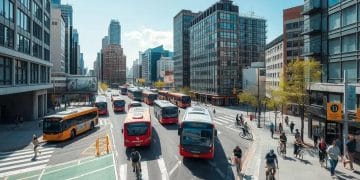Federal budget overview: What you need to know

The federal budget overview highlights key components such as revenue sources, spending categories, and their impacts on local economies, along with future trends in sustainability and technology investments.
Federal budget overview provides a comprehensive look at how taxpayer dollars are allocated. Have you ever wondered where your money goes? Let’s dive into the intricate details that shape our economy.
Understanding the federal budget process
Understanding the federal budget process is essential for grasping how our government functions. At its core, the budget reflects the priorities of the nation. Each year, the process begins with the President submitting a proposed budget plan to Congress.
The Role of Congress
Once the proposal is delivered, Congress takes action. They review the budget and can make changes. Committees hold hearings to gather information and opinions from various stakeholders, which helps shape the final budget.
Key Steps in the Process
- The President submits the proposed budget.
- Congress reviews and debates the proposal.
- Committees revise the budget based on feedback.
- The final budget is approved by both houses of Congress.
The approval process can be contentious, often involving discussions and negotiations among various political factions. A balanced budget helps prevent economic issues and maintains fiscal responsibility. However, sometimes disagreements can lead to delays or government shutdowns, which impact federal operations and services.
As the fiscal year approaches, the importance of understanding these processes increases. Budget decisions affect numerous aspects of everyday life, from education funding to healthcare services. Keeping informed about how the federal budget is managed gives citizens a clearer picture of how their tax dollars are spent.
Key components of the federal budget
Understanding the key components of the federal budget is vital for recognizing how government funding impacts our lives. The federal budget comprises several important parts, each playing a significant role in the economy.
Revenue Sources
The federal government generates funds mainly through taxes. These can include income tax, corporate tax, and payroll tax. Each year, the estimated revenue helps dictate how much money can be allocated to various sectors.
Mandatory vs. Discretionary Spending
In the budget, spending is classified into two main categories: mandatory and discretionary. Mandatory spending covers programs like Social Security and Medicare, which are required by law. Discretionary spending, on the other hand, includes areas like education and defense, where Congress has more flexibility to make changes.
- Mandatory spending: Social Security, Medicare, Medicaid.
- Discretionary spending: Education, Transportation, Defense.
- Interest on debt: Payments made to service the national debt.
The allocation of funds doesn’t just happen arbitrarily. Various factors influence how the budget is crafted, including economic trends and political priorities. Understanding these components can make you more aware of how your tax dollars are used.
Moreover, the federal budget reflects the nation’s goals and visions. Every year, priorities might shift depending on the needs of the country, whether it’s healthcare, infrastructure, or national security. Keeping track of these changes helps citizens better understand the direction their government is heading.
How federal budgets impact local economies

How federal budgets impact local economies is a critical topic for understanding regional funding and resource allocation. The federal budget influences various sectors, from education to transportation, affecting daily lives at the local level.
Federal Funding Allocations
Through federal budgets, critical funds are allocated to programs that support local communities. This can enhance services such as public education and healthcare, leading to improved quality of life. Local governments often rely on these funds to fill gaps that cannot be covered by state or local revenue.
Job Creation and Economic Growth
When federal funds are invested in local infrastructure projects, such as roads and bridges, it can create jobs. This not only boosts employment rates but also can lead to a multiplier effect, where the money spent circulates through the local economy, benefiting numerous businesses.
- Examples of federal funding: Grants for local schools, healthcare initiatives, public transportation improvements.
- The impact on jobs: Construction, education, and healthcare sectors often see job growth.
- Long-term benefits: Improved infrastructure leads to increased property values and community development.
The relationship between federal budgets and local economies underscores the importance of civic engagement. Understanding how budget decisions are made can empower citizens to advocate for their community’s needs. Ensuring the best distribution of resources can lead to sustainable growth and development.
Moreover, local economies thrive when federal support aligns with community priorities. This connection highlights the need for transparency in budget processes, allowing residents to see how their taxpayer dollars are utilized for local benefits.
Challenges in balancing the federal budget
Challenges in balancing the federal budget are significant and complex. Every year, policymakers face tough decisions that impact how the government collects and spends money. Understanding these challenges helps clarify why some decisions may not align with public expectations.
Political Disagreements
One major challenge is political disagreements among lawmakers. Different parties and interests often have conflicting priorities. For example, one group may push for increased spending in education while another advocates for cutting taxes. These differences can lead to gridlock, where progress stalls.
Rising Debt Levels
Another challenge is the growing national debt. As expenses rise, especially for mandatory programs like Social Security and Medicare, balancing the budget becomes harder. Managing the debt requires careful planning and often results in difficult choices about funding other important programs.
- Mandatory spending: Programs that must be funded by law, limiting flexibility.
- Discretionary spending: Areas where cuts can be made, such as defense and education.
- Interest payments: Growing costs associated with servicing the national debt.
Economic factors also play a significant role in budget balancing. Economic downturns can lead to decreased revenue from taxes, making it harder to cover expenses. Additionally, unexpected events like natural disasters or pandemics can strain resources even further, complicating budget planning.
Overall, addressing these challenges requires a balanced approach. Policymakers must weigh immediate needs against long-term sustainability. Citizens can play a role by staying informed and engaging in discussions about fiscal responsibility and priorities.
Future trends in federal budgeting
Future trends in federal budgeting are crucial for understanding how government priorities may shift in the coming years. As society evolves, so do the needs for funding in different areas. These trends can give insights into what to expect in terms of government spending and investments.
Increased Focus on Sustainability
One of the most significant future trends is the increasing emphasis on sustainability. As climate change becomes a pressing global issue, federal budgets are likely to allocate more funds for renewable energy and conservation projects. This shift can lead to investments that promote cleaner technologies and a greener economy.
Technology and Innovation Investments
With the rapid pace of technological advancement, federal budgets are likely to prioritize funding for innovation. This includes support for research and development, especially in areas like healthcare technology, cyber security, and infrastructure improvements. These investments can enhance public services and efficiency.
- Green energy projects: Funding for solar, wind, and other renewable energy technologies.
- Healthcare innovations: Investments in telehealth and medical research.
- Infrastructure modernization: Funding for smart city initiatives and transportation upgrades.
Another trend involves constitutional changes and reforms. As the public becomes more aware of fiscal responsibility, there may be movements toward requiring stricter budgetary constraints and transparency measures. This could lead to significant changes in how budgets are proposed and reviewed.
Overall, understanding these future trends allows citizens to engage with their government more effectively. By staying informed about potential changes in federal budgeting, individuals can advocate for policies that truly benefit their communities and align with their values.
FAQ – Frequently Asked Questions about Federal Budgeting
What are the main components of the federal budget?
The federal budget includes revenue sources like taxes and spending categories such as mandatory and discretionary spending.
How does federal budgeting impact local communities?
Federal budgets allocate funds for local programs like education and infrastructure, directly affecting community resources and services.
What challenges do lawmakers face in balancing the federal budget?
Lawmakers deal with political disagreements, rising debt levels, and the need to fund mandatory programs, making budget balancing complex.
What future trends are emerging in federal budgeting?
Future trends include a focus on sustainability, technology investments, and greater civic engagement in budgetary discussions.





